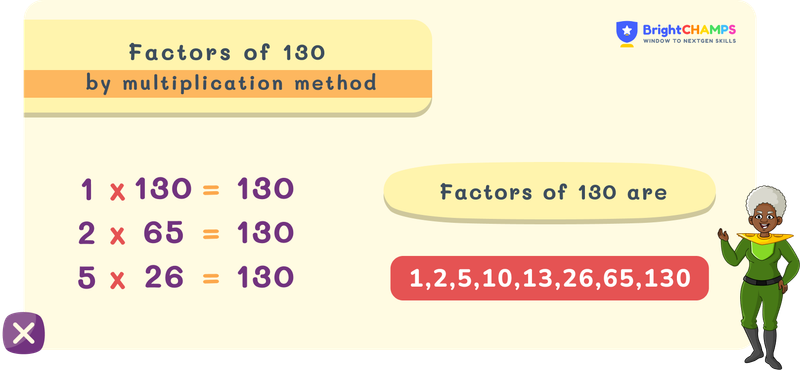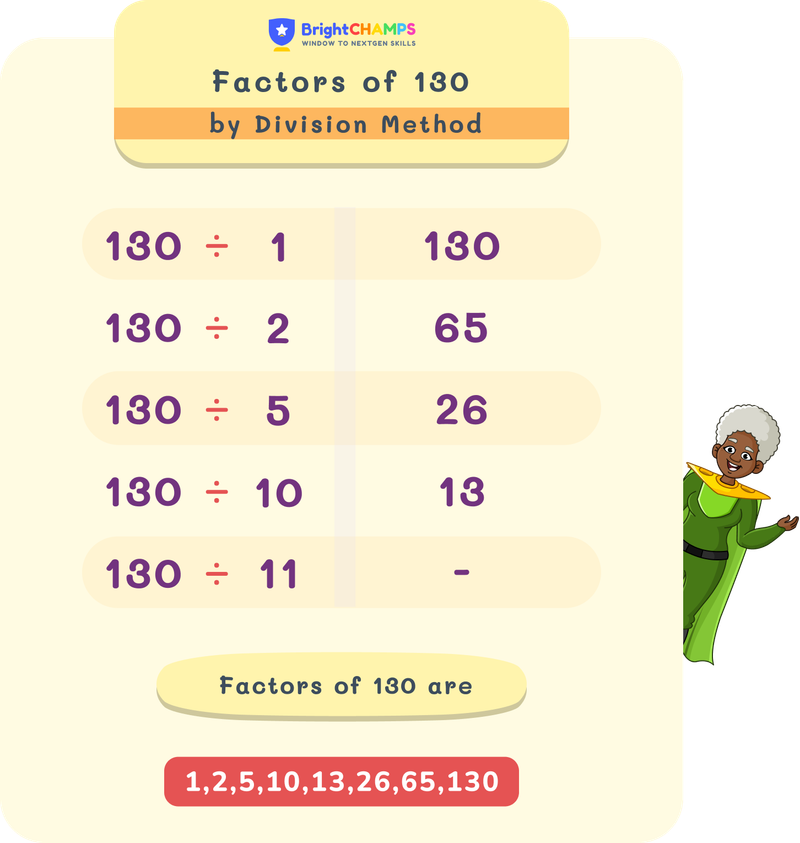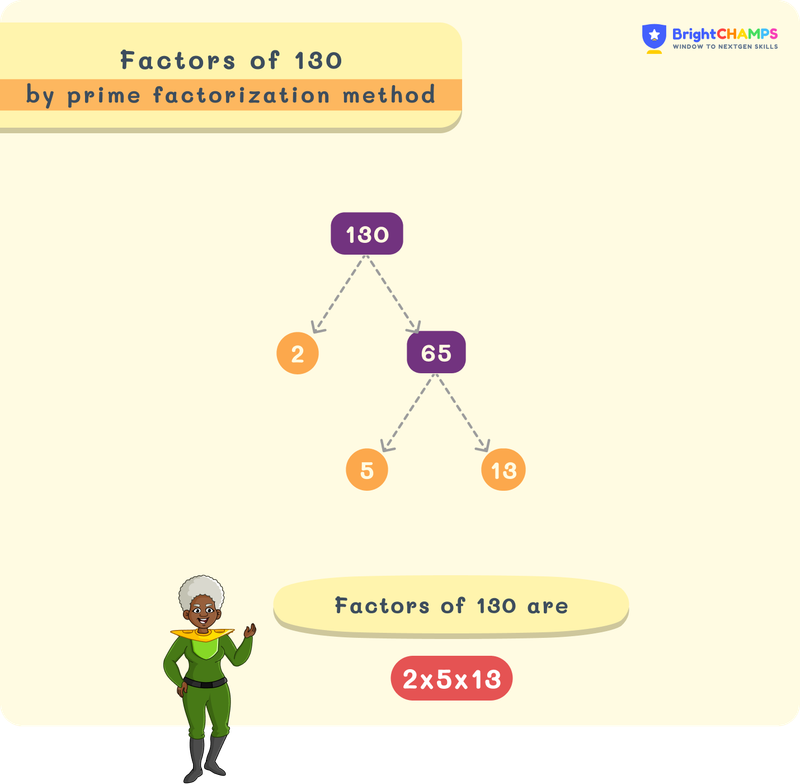
 401 Learners
401 LearnersLast updated on May 26th, 2025

Factors of 130

Factors of any number are the dividers or multipliers that can divide the number fully and can be multiplied together to produce the given product, 130. Do you know, factors form the basic approach to solve some general mathematical procedures? This article will give you the insights of factors of 130.
What are the Factors of 130?
The factors of 130 or the numbers which divide 130 exactly are:
1,2,5,10,13,26,65, and 130.
Negative factors of 130: -1,-2,-5,-10,-13,-26,-65,-130.
Prime factors of 130: 2,5,13
Prime factorization of 130: 2×5×13
The sum of factors of 130: 1+2+5+10+13+26+65+130= 252
Struggling with Math?
Get 1:1 Coaching to Boost Grades Fast !

How to Find the Factors of 130
For finding factors of 130, we will be learning these below-mentioned methods:
- Multiplication Method
- Division Method
- Prime Factor and Prime Factorization
- Factor Tree
Finding Factors using Multiplication Methods
This particular method often finds the pair of factors which, on multiplication together, produces 130. Let us find the pairs which, on multiplication, yields 130.
1×130=130
2×65=130
5×26=130
10×13=130

So, factors of 130 are: 1,2,5,10,13,26,65, and 130.
Finding Factors using Division Method
The division method finds the factors that evenly divides the given number 130. In this process, we have to divide 130 by all possible natural numbers less than 130 and check.
1,2,5,10,13,26,65, and 130 are the only factors that the number 130 has. So to verify the factors of 130 using the division method, we just need to divide 130 by each factor.
130/1 =130
130/2=65
130/5=26
130/10=13
130/13=10
130/26=5
130/65=2
130/130=1

Prime Factors and Prime Factorization
Prime Factorization is the easiest process to find prime factors. It decomposes 130 into a product of its prime integers.
Prime Factors of 130: 2,5,13.
Prime Factorization of 130: 2×5×13
Factor tree
The number 130 is written on top and two branches are extended.
Fill in those branches with a factor pair of the number above, i.e., 130.
Continue this process until each branch ends with a prime factor (number).
The first two branches of the factor tree of 130 are 2 and 65, then proceeding to 65, we get 5 and 13. So, now the factor tree for 130 is achieved.

Factor Pairs
Positive pair factors: (1,130), (2,65), (5,26), (10,13).
Negative pair factors: (-1,-130), (-2,-65), (-5,-26), (-10,-13).

Common Mistakes and How to Avoid Them in Factors of 130
Solving problems based on factors can, sometimes, lead to misconceptions among children. Let us check what the common errors are and how to avoid them.
Level Up with a Math Certification!
2X Faster Learning (Grades 1-12)


Factors of 130 Examples

Problem 1
A baker has 65 cupcakes and 130 cookies. He wants to divide them equally among some plates. What is the maximum number of plates he can use?

Number of cupcakes: 65
Number of cookies: 130
Factors of 65: 1,5,13,65
Factors of 130: 1,2,5,10,13,26,65,130
Common factors of 65 and 130: 1,5,13,65.
Greatest common factor of 65 and 130: 65
So, there will be 65 plates he can use.
Answer: 65 plates
Explanation
To divide equally, the maximum number of plates can be found through the Greatest Common Factor. Here, we found the GCF, which is the answer.

Problem 2
Two trains leave a station at the same time. One leaves every 65 minutes and the other every 130 minutes. When will they leave together again?

Time-lapse of the 1st train: 65 minutes
Time-lapse of the 2nd train: 130 minutes
Prime factorization of 65: 5×13.
Prime factorization of 130: 5×2×13.
LCM of 65 and 130: 5×2×13 = 130.
Both the trains will meet each other after 130 minutes.
Answer: 130 minutes
Explanation
To find the time again when two trains will meet, we have to find the LCM of the two given time-lapses. So, did prime factorization of both 130 and 65. The LCM is the product of the highest power of each factor.

Problem 3
The area of a rectangle is 130 square units. If the length is 10 units, then what is the measure of its width?

Area of rectangle: 130 sq units
Factors of 130: 1,2,5,10,13,26,65,130
We know that the area of a rectangle is the product of its length and breadth.
Given, length= 10 units
There exists a factor pair of 130, which is (10,13). Hence, width is 13 units. Let’s check it through the formula for area.
So, length×width = area
⇒ 10 × width = 130
⇒ width = 130/10 = 13
Answer: 13 units
Explanation
Used the concept of factor pairs for 130 and rechecked using the formula for finding area of a rectangle.

Problem 4
Find the smallest number that is divisible by 5,10, and 13.

Prime factorization of 5: 5×1.
Prime factorization of 10: 5×2
Prime factorization of 13: 13×1
LCM of 5,10 and 13: 5×2×13 = 130
Answer: 130 is the smallest number which is divisible by 5,10, and 13.
Explanation
To find the smallest number which is divisible by 5,10,13, we need to find the LCM of these numbers.

Problem 5
If a number is divisible by both 2 and 65, is it divisible by 130?

Yes, any number which is divisible by 2 and 65 is also divisible by 130, since 130 = 2×65
Explanation
Any number which is divisible by the factor 2 and factor 65 of 130, then it is also divisible by 130 because 130 is a product of 2 and 65.

Turn your child into a math star!
#1 Math Hack Schools Won't Teach!


FAQs on Factors of 130
1.How to make 130 in multiplication?
2.What are multiples of 130?
3.How many divisors does 130 have?
4.What times 13 equals 130?
5.What is 8 multiplied by 130?
6.How can children in Qatar use numbers in everyday life to understand Factors of 130?
7.What are some fun ways kids in Qatar can practice Factors of 130 with numbers?
8.What role do numbers and Factors of 130 play in helping children in Qatar develop problem-solving skills?
9.How can families in Qatar create number-rich environments to improve Factors of 130 skills?
Struggling with Math?
Get 1:1 Coaching to Boost Grades Fast !

Important Glossaries for Factors of 130
- Multipliers - Number which multiplies or a number by which another number is multiplied.
- Dividers - A number that divides.
- Prime Factorization - It involves factoring the number into its prime factors.
- Prime factors - These are the prime numbers which on multiplication together results into the original number whose prime factors are to be obtained.
- Composite numbers - These are numbers having more than two factors.
- Multiple - It is a product of the given number and any other integer.
Explore More numbers
![Important Math Links Icon]() Previous to Factors of 130
Previous to Factors of 130
About BrightChamps in Qatar


Hiralee Lalitkumar Makwana
About the Author
Hiralee Lalitkumar Makwana has almost two years of teaching experience. She is a number ninja as she loves numbers. Her interest in numbers can be seen in the way she cracks math puzzles and hidden patterns.
Fun Fact
: She loves to read number jokes and games.




